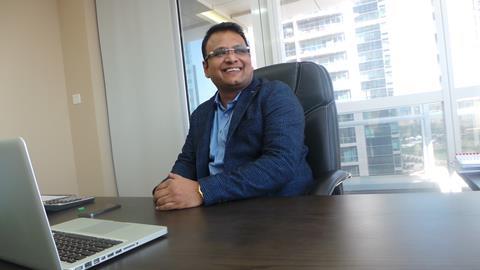Although new to the business, Indian producer Manish Mundra has already backed films that have won prizes in Sundance and Berlin. He tells Liz Shackleton about his plans to finance and distribute content-driven Indian cinema.

The CEO of Nigeria-based oil company Indorama Eleme, Manish Mundra was drawn into the film business around a year ago when he read tweets from actor-filmmaker Rajat Kapoor complaining that he couldn’t raise money for his new film. Mundra stepped in to finance and produce Kapoor’s family drama Ankhon Dekhi, which won critical acclaim in India and overseas.
He also connected with the producer of Prashant Nair’s Umrika via Twitter and the film went on to win the audience award in the Sundance Film Festival’s World Cinema Dramatic Competition. His third production, Nagesh Kukunoor’s Rainbow (Dhanak) has just clinched two prizes in Berlin’s Generation Kplus section – the Grand Prix for best feature-length film and a children’s jury special mention for best feature.
Focused on content-driven cinema, Mundra aims to offer an alternative to India’s “mass entertainers” and Bollywood stars. His Mumbai-based Drishyam is now producing a slate of films including Neeraj Ghaywan’s Indo-French co-production Masan, Anu Menon’s Waiting and an experimental project X The Film, which has 11 directors contributing to the same story.
Why did you decide to jump into film financing and production?
The film bug was always there and became stronger in the last 10-15 years when you could see that Hindi films across the world were not being taken seriously. I wanted to enter cinema and make real Indian stories – we have hundreds of beautiful stories that can be told and viewed worldwide.
Social media is one of the best routes into this world so I started following those filmmakers you can actually believe in. I believe in Rajat Kapoor – he makes realistic cinema that has the potential to travel. So when I saw his Twitter message, “no-one believes in me, I’m leaving film and going back to theatre”, I wrote back and said if you don’t mind I can produce your film. He responded and I read his script and really became connected to it.
Umrika also happened through Twitter. Swati Shetty was producing and already shooting, but needed funds to finish, so she found me on Twitter. I saw the part that had already been shot and decided to jump.
So you must be inundated with social media requests now?
I have a lot of love mails, tweets and inbox messages. But I’m very clear about one thing, that I must first go through the script. I need to read the script and sit with the director – and if I feel a connection I immediately decide to just do it.
I love films that deal with human behavior and relationships. Masan weaves three stories about different kinds of relationships and also talks about redemption. Waiting is about a man whose wife is in a coma and how he interacts with a doctor and a young woman in a similar position in the same hospital.
Do you usually fully finance the films you produce?
I’ve tried different models – Ankhon Dekhi was fully financed by me. Umrika had some investment already there. Masan is a co-production with [India’s] Phantom Films, Arte, Pathe and [Melita Toscan du Plantier’s] Macassar. Indian films need co-production to travel. It also reduces your financial liability.
I make films using my salary, so I need to choose my films and partners very carefully. I strongly feel that films are a form of art and shouldn’t be viewed only from a business perspective. But I have limited funds so go through the whole process very judiciously.
Will your films receive a theatrical release in India? Will local audiences get to see them?
Drishyam is also entering distribution and will release both Umrika and Rainbow later this year. All my investments include a commitment towards p&a.
But isn’t it difficult to release niche films in India?
The market is going to change and it is changing. There are more people like me who believe in content-driven cinema. India has a huge audience but the key is to keep budgets low. If you can make a film for half a million dollars and draw 200,000-300,000 viewers in the first few days, then you can break even. You can make profits from satellite and other rights.
The trick is to build a brand and to build the trust of the audience. Those who came to see Ankhon Dekhi will definitely come to see Umrika. Then they’ll also come to see Masan or Rainbow or Waiting. If you continuously deliver strong content then the audience will move with you and love your kind of cinema.
Social media is also a tool – people love to connect, see what you have to present and give you a chance. A year after Ankhon Dekhi was released, I still get messages about the film and I make it a point to reply to them. There’s still a lot of work to be done as one full generation of Indian audience has been disappointed. So we need to treat them with some other delicacies to bring them back.
Will all your investments be in Hindi films?
Hindi cinema floundered somewhere in the last ten years and needs some good content-driven films. But I also need to do some international films to understand that journey, so I’m looking to do co-productions in English and French. They don’t necessarily need an Indian element. If you sit with a French company and make a French film that you both love, then you can more easily propose a Hindi film to them. It’s give and take.
Will you also enter international sales?
We have Beta Cinema selling Umrika. I feel our responsibility as Indian producers, directors and writers is to make good cinema that travels across the world. Then the distributors will come to us to find more films like The Lunchbox.

























No comments yet